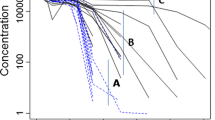Abstract
Formulation changes at later stages of biotherapeutics development require biocomparability (BC) assessment. Using simulation, this study aims to determine the potential effect of bias difference observed between the two formulations after spiking into serum in passing or failing of a critical BC study. An ELISA method with 20% total error was used to assess any bias differences between a reference (RF) and test formulations (TF) in serum. During bioanalytical comparison of these formulations, a 9% difference in bias was observed between the two formulations in sera. To determine acceptable level of bias difference between the RF and TF bioanalytically, two in silico simulations were performed. The in silico analysis showed that the likelihood of the study meeting the BC criteria was >90% when the bias difference between RF and TF in serum was 9% and the number of subjects was ≥20 per treatment arm. An additional simulation showed that when the bias difference was increased to 13% and the number of subjects was <40, the likelihood of meeting the BC criteria decreased to 80%. The result from in silico analysis allowed the bioanalytical laboratory to proceed with sample analysis using a single calibrator and quality controls made from the reference formulation. This modeling approach can be applied to other BC studies with similar situations.




Similar content being viewed by others
References
Wang D et al. Clinical trials a practical guide to design, analysis and reportings. Chapter 13 bioequivalence trials.
DeSilva B et al. Recommendations for the bioanalytical method validation of ligand-binding assays to support pharmacokinetic assessments of macromolecules. Pharm Res. 2003;20:1885–900.
Thway TM et al. Applications of a planar electrochemiluminesce platform to support regulated studies of macromolecules: benefits and limitations in assay range. J Pharm Biomed Anal. 2010;51:626–32.
Van Peer A. Variability and impact on design of bioequivalence studies. Basic Clin Pharmacol Toxicol. 2010;106:146–53.
Acknowledgments
Financial support for this research was provided by Amgen Inc. All authors own Amgen stocks. We would like to thank Dr. Michael Hall and Dr. Vibha Jawa (both from Amgen Inc) for their critical review and Dr Jeffery Talbot for providing editorial support.
Author information
Authors and Affiliations
Corresponding author
Rights and permissions
About this article
Cite this article
Thway, T.M., Macaraeg, C., Eschenberg, M. et al. In Silico Evaluation of the Potential Impact of Bioanalytical Bias Difference between Two Therapeutic Protein Formulations for Pharmacokinetic Assessment in a Biocomparability Study. AAPS J 17, 684–690 (2015). https://doi.org/10.1208/s12248-015-9741-9
Received:
Accepted:
Published:
Issue Date:
DOI: https://doi.org/10.1208/s12248-015-9741-9




